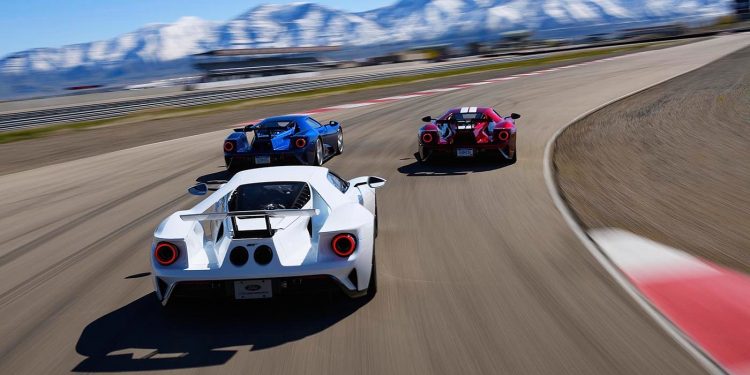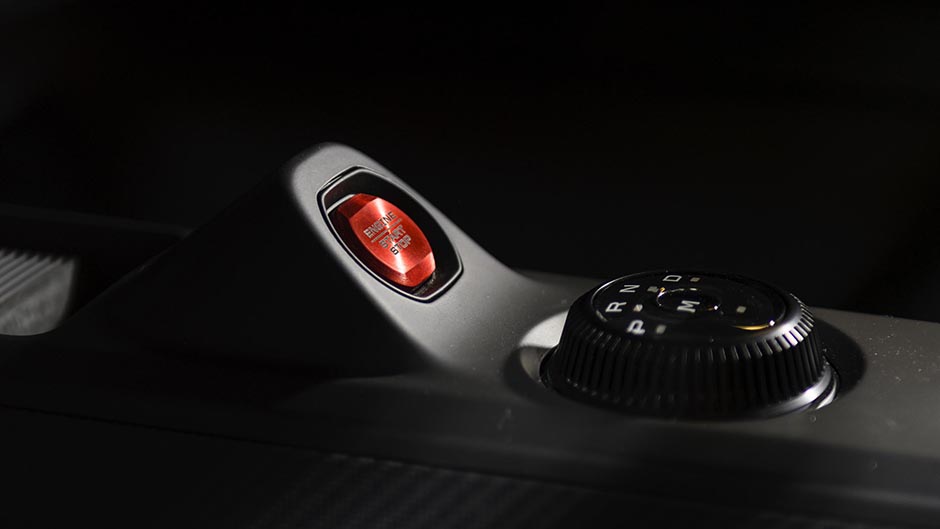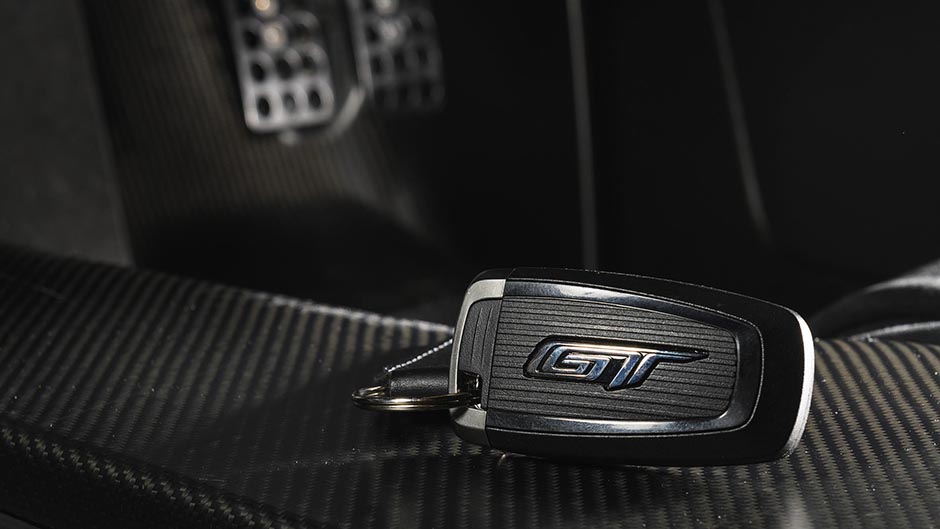2017 Ford GT launch report
Words: Peter Louisson | Photos: Supplied
An opportunity to drive the new Ford GT was an unexpected surprise, akin to its shock debut at the Detroit Motor Show in 2015. We head stateside for its international launch.
As a motoring writer you’re often asked what’s the best car, and you feel compelled to qualify the question with at least a price point. Under $50k, and the answer is relatively simple, MX-5. But price unlimited is much more difficult. And now there’s a new Ford GT to add to the list of contenders.
But this car has a genuine shot at the title. Some aspects are arguably state of the art, including steering, handling, brakes, ride quality, and its exceptional appearance, a mix of race car-inspired width, aeros, and ground-hugging height, along with supercar-inspired wild lines and musculature.
The person asking the question will probably think you’re mad. A car wearing the blue oval vying for the title of best supercar? Could a company producing the humble Fiesta also create a world-class super sports machine?

The people at Ford involved in “Project Silver” (second-gen GT) have been asked that question repeatedly. For that matter, I’d wondered for a time what I was doing at the Utah Motorsport Campus, about to drive their baby when they’re only being produced in left hand drive and production numbers are limited. The reason would become clear after hearing team members outline the development of the vehicle.
For those tasked with creating the latest endurance racer-cum-road warrior counter the johnny-come-lately tag by saying that the car didn’t just happen overnight; the company has been working to get to this point for over 50 years. It all began with the GT40 that was built to beat the best from Ferrari in the sixties, after Ford’s takeover bid for the Italian company was rebuffed at the last minute. After realising that they were a pawn in an all-Italian game, Ford decided to counter with a car that would topple a Ferrari, and to this day the raison d’etre of the Ford GT is to beat the best in endurance racing. That it just so happens to wear the blue oval and competes with some of the supercar opposition on price is beside the point.
The original supercar from Ford, the GT40, didn’t win straight off the bat but it did eventually clean up at the Le Mans 24-hour race, finishing 1, 2 and 3 in 1966 (with Kiwis McLaren and Amon at the helm). It would win the iconic race four years in a row.

With that, Ford, the maker of people’s cars in the US, could have gone home with its head held high and forgotten all about contesting in the rarified arena but the seed was sown and in 2005 the company returned with a car simply known as the GT. It was conceived to mark the 2003 centenary celebrations of the company. Just over 4000 examples of the V8-powered aluminium-bodied mid-engined supercar were built, though the car never competed at Le Mans.
So why has Ford reprised the GT? Firstly, 2016 represented 50 years since the historic 1, 2, 3 finish at the Le Mans 24-hour race, and secondly the company boffins learn vast amounts in the development of leading-edge machinery. Some of that new technology ends up in mass market cars eventually, giving them a point of difference over the competition. And it was precisely for that reason that we were invited to hear about the development of the GT and to drive it afterwards.
The latest GT has been some time in the making. This was a secret-squirrel skunkworks development, a windowless cellar used for design and engineering purposes, with all members sworn to secrecy. The cone of silence was so effective that when the car was unveiled at the 2015 Detroit Motor Show, it was a complete shock to the outside world. And a stunning one at that. It is a breathtaking piece of automotive art to behold, a sensational mix of form and function.

We heard from Jamal Hameedi, Ford Performance Chief Engineer, involved in the development of the car, a technology showpiece and a hero vehicle for the go-fast division. He said aerodynamics would prove key to the project and would even dictate engine type, for low drag and frontal area, and balanced downforce were considered essential for the race car. Hence the teardrop-shaped passenger cell, tapering towards the rear.
A V8 wouldn’t fit, necessitating a V6. The engine used in the GT is based in part on the Daytona race engine, and in part on the 3.5L EcoBoost mill in the F 150 Raptor. With twin turbos and a maximum 30 pounds of boost it generates almost 650bhp (485kW) and near on 750Nm, the latter across a broad spread of revs.
The following day we were to check out the power and glory of the V6 mill on track, only as I was set to go thunder clapped and rain arrived, delaying proceedings for a time. The organisers suggested we take to the road instead, a good opportunity to familiarise ourselves with the car. Entry through the dihedral door into the low-set driver’s seat is not such a mission, the big sill of the carbon tub not so much in the way. But a head-first entry is best, and you’re soon ensconced low in the leather-clad driver’s seat. This and the cabin are almost cocoon-like, a sensation enhanced by the close proximity of my driving partner. It’s cosy, tight even with a helmet on as we’d later discover on track. But once the pedals and wheel are adjusted to suit, it’s all as you’d like it.

Time to hit the go button and the engine fires and settles into an easily audible growl from behind. In the centre console is a rotary PRND dial with a central button for manual transmission mode, behind which are ESP off, a comfort setting for the dampers, the nose lift button and an electronic parking brake. And that’s about it! All the rest of the controls are wheel-mounted, including alloy shift paddles, indicators, wipers, cruise control and the rotary mode switch. No soft furnishings of note, but the seat is comfy, unlike some race specials.
Because of rain, we select the wet mode which delivers a wimpy 600hp instead of the full 650, and we’re underway, the GT easing away quite smoothly, considering it’s a twin-clutch transmission. The weather rapidly improves and we’re soon into Normal mode, the engine perking up noticeably.
Two things are immediately apparent. We don’t need the comfort setting for the dampers; the GT is perfectly pliant over the concrete expansion joints as is. And the steering wheel, swathed in high-grip suede, is just alive with info, telegraphed via low profile 245/30ZR20 rubber. Exhaust aside, the car’s eerily quiet with little wind noise.

Up into nearby foothills and the roads empty and turn feral. We’ve been mooching along at 110 with less than 2000rpm showing, and it’s time to light the wick. As engine revs rise so does clamour, the V6 emitting a guttural roar behind, without quite the emotive scream of a traditional supercar. Its 11 litres of ‘boot’ space is more typical! The roadholding, steering and brakes are top flight though. Grip is sensational, thanks to the top flight Michelin rubber, the huge wheel tracks and the low ride height. Contributing is a racy weight balance of 43/57 front to rear. The GT arcs through the corners with seemingly non-existent body roll and we’re soon at the top of the pass, pulling a quick U-turn and heading back down again. The standard carbon ceramics are the best I’ve encountered on any vehicle, probably because of the GT’s comparatively light weight.
All too soon and I reluctantly hand over the wheel to my driving partner. We attach the Q-Starz timing device and find that two-up the GT repeatedly clicks off 80-120 times of just 1.8sec (52m), putting it up amongst the fastest machines we’ve tested. On the first emergency stop it comes to a halt in 32m. The brakes are simply stupendous, a mere brush needed to wash away excess speed. And this is without the effect of the aero brake.
Back at the track and we’re first in line because of the rain delay. This time, it’s all a bit different as we’re in a Hans device and helmet, and strapped in with a six-point harness. Head clearance, a bit tight before is now more problematic, requiring a rearward tilt of the seat back. Dan, our friendly circuit expert suggests selecting Track mode, and the hydraulics lower the car down to its minimum ride height.

The track, formerly known as Miller, is flat and technical, with many a late apex and decreasing radius. It’s a hard one to learn quickly but with a couple of sighting laps we gain speed and there follow a few at pace.
Everything we noted on road is still there in spades, the sharp informative helm, the astounding brakes and the sensational grip but it’s all turned up another level in Track mode, the wing is doing its thing and the electronic safety bits backed off slightly. Despite pushing to limits that I’m comfortable with – no-one wants to be that person of infamy – I get the feeling I’m not really troubling this car; there’s no squealing of tyres and only the merest hint of understeer, quelled by a throttle lift. With the active wing, we’re repeatedly arriving at turns having washed off too much speed. This is hard to recalibrate; you’re fearful of going too far in the opposite direction.
Using the broad spread of torque, and instantaneous throttle response – there is no turbo lag – we’re soon down to well under 2min a lap but we’re about to find out what the GT can really do. Out of the driver’s seat – sadly over all too quickly – and in hops Ryan Briscoe of IndyCar fame. He soon has the GT dancing, making much greater use of its profound lateral grip – you’d swear it was 4wd on a dry track – and it’s so beautifully balanced on the throttle it rarely pushes, though the rear occasionally skips momentarily under full power. He’s generally in fourth gear, the muscular torque of the engine dragging us out of turns and soon produces laps of 1.36, all seemingly within his comfort zone.

I’ve been on track in some exotic machinery before but in nothing quite so talented as this. And for it to translate those talents to the road without rattling your eyeballs is testament to the ingenious work of the engineers, conjuring up a novel suspension solution that makes this truly a dual-purpose supercar. So is it the best car, cost no object? Not having driven all the competition that’s impossible to say. It’s certainly the most competent car I’ve ever driven though, and one of the quickest.
While it’s possible one or two GTs may make their way here, it’s the potential for use of technology developed in the GT that makes this car relevant to Kiwis. The fully digital dash is already being sorted for the 2018 Mustang and you can bet aspects of the GT’s suspension technology and novel aerodynamic solutions will end up in Ford Performance models eventually, and possibly even the component carbon technology. It works and we can’t wait.














